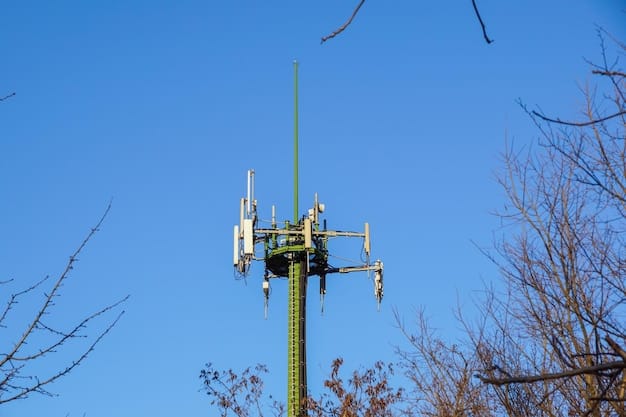5G Expansion in US: Progress, Bottlenecks, and Future Outlook

The expansion of 5G networks across the US is proceeding with significant strides, yet faces notable challenges including regulatory hurdles, infrastructure costs, and the complex deployment of dense small cell networks, all of which impact nationwide availability and performance.
The promise of 5G—ultra-fast speeds, minimal latency, and massive connectivity—has captivated the imagination of technologists and consumers alike. But how is 5G expansion progressing across the US, and what are the bottlenecks impeding its full realization? This in-depth look explores the complex landscape of 5G deployment, from its technological foundations to the multifaceted challenges hindering its ubiquitous presence.
The State of 5G Deployment in the US
The journey to blanket the US with 5G connectivity has been a dynamic one, marked by ambitious rollouts from major carriers, significant infrastructure investments, and evolving technological standards. From urban centers to increasingly rural areas, the footprint of 5G continues to expand, though not always uniformly or with the same level of performance.
Carriers have largely pursued a multi-pronged strategy, deploying 5G across different spectrum bands. Low-band 5G offers broad coverage, often leveraging existing 4G infrastructure, making it more accessible but with speeds only modestly faster than LTE. Mid-band 5G delivers a balance of speed and coverage, becoming the preferred choice for many and often serving as the “sweet spot” for everyday use. High-band 5G, or millimeter-wave (mmWave), provides blistering speeds but is highly susceptible to interference and has limited range, requiring dense deployments, typically in specific high-traffic areas.
Spectrum Allocation and Carrier Strategies
The allocation of wireless spectrum is foundational to 5G deployment, dictating what speeds and coverage areas are feasible for different carriers. The Federal Communications Commission (FCC) has played a pivotal role in auctioning off various spectrum bands, influencing how carriers shape their 5G strategies. This complex dance between regulation and innovation largely determines the pace and nature of 5G rollout.
- Low-band spectrum: Often repurposed from LTE networks, this spectrum offers wide coverage and penetrates buildings well, but provides modest speed increases.
- Mid-band spectrum: This “C-band” spectrum has become crucial, offering a strong balance of speed and coverage, ideal for urban and suburban environments.
- High-band (mmWave) spectrum: Delivers the fastest speeds but has very limited range and struggles with obstacles, best suited for dense urban hot spots.
Each carrier has embraced a unique approach based on their existing spectrum holdings and strategic objectives. This has resulted in a patchwork of 5G experiences across the country, where availability and performance can vary significantly depending on location and carrier. Understanding these underlying strategies is key to comprehending the current landscape of 5G in the US.
Infrastructure Challenges and Investments
Building out a national 5G network is not merely a matter of flipping a switch; it demands an unprecedented scale of infrastructure development and capital investment. Unlike previous generations, 5G requires a far denser network of cell sites, particularly for the faster mmWave frequencies, which brings its own set of logistical and financial hurdles.
Existing tower infrastructure, while foundational, isn’t always sufficient. The proliferation of small cells—compact base stations that can be installed on streetlights, utility poles, and building facades—is critical for overcoming the limited range of high-frequency 5G signals. This necessitates navigating local zoning ordinances, acquiring extensive site leases, and connecting these myriad nodes back to the core network with robust fiber optic lines.
The Fiber Backhaul Imperative
A high-speed, low-latency 5G network is only as good as its backhaul—the connection from the cell site to the central network. Fiber optic cables provide the necessary bandwidth and reliability for 5G’s demanding requirements. However, laying new fiber is an expensive and time-consuming endeavor, especially in areas where existing infrastructure is sparse or non-existent.
- Geographic disparities: Urban areas generally have more fiber infrastructure, while rural and underserved regions face significant challenges.
- Cost and complexity: Digging trenches, navigating underground utilities, and obtaining permits for fiber deployment are major capital expenditures and logistical headaches.
- Competitive landscape: Multiple providers often vie for access to the same rights-of-way, complicating rollout efforts and potentially leading to redundant infrastructure.
The ongoing push to expand fiber optic networks is a quiet but critical component of 5G deployment. Without this robust backhaul, even the most advanced radio access networks (RANs) would be unable to deliver on 5G’s full potential. The investment in fiber is not just an infrastructure cost; it’s an investment in the future capabilities of the network.

Regulatory and Permitting Bottlenecks
Beyond the technical and financial aspects, the expansion of 5G networks in the US is heavily influenced by a complex web of regulatory frameworks and local permitting processes. These often-overlooked elements can significantly slow down deployment, adding layers of bureaucracy and cost that impact the pace of innovation and equitable access.
At the federal level, agencies like the FCC establish overarching guidelines for spectrum use and network deployment. However, it’s at the state and local levels that many of the immediate hurdles arise. Municipalities, counties, and various local authorities each have their own zoning laws, aesthetic standards, and permitting procedures for installing new cell sites, particularly small cells.
Navigating Local Ordinances and NIMBYism
The decentralization of permitting authority means that carriers must engage in myriad individual negotiations with thousands of local jurisdictions. This can lead to inconsistencies, delays, and a lack of standardized processes, transforming what should be a straightforward engineering task into a protracted legal and administrative battle. Furthermore, public resistance, often referred to as NIMBY (Not In My Backyard) sentiment, around the visual impact or perceived health effects of cellular infrastructure can further complicate matters.
- Inconsistent regulations: Varying aesthetic requirements, height restrictions, and application processes across different localities create significant inefficiencies.
- Permitting delays: The time required to obtain necessary permits can stretch for months, or even years, delaying network activation.
- Public pushback: Community concerns regarding aesthetics, property values, or unfounded health fears can lead to opposition to new installations.
Addressing these regulatory and permitting bottlenecks requires a concerted effort from all stakeholders: federal agencies providing clear guidance, state legislatures promoting streamlined processes, and local governments embracing a collaborative approach. Without such reforms, achieving widespread 5G coverage efficiently will remain an uphill battle.
Economic and Supply Chain Factors
The ambitious rollout of 5G across the US is also subject to significant economic and supply chain pressures, influencing everything from equipment acquisition to labor availability. These factors, often global in nature, can introduce volatility and uncertainty into deployment schedules and overall costs.
The capital expenditure (CapEx) required for 5G infrastructure is immense. Carriers are investing billions of dollars in acquiring spectrum, purchasing network equipment, and deploying new cell sites. This financial outlay is continuous and long-term, requiring careful budgeting and strategic prioritization. Beyond the upfront costs, ongoing operational expenditures (OpEx) for maintenance, power, and site leases add to the financial burden.
Global Component Shortages and Geopolitical Tensions
The intricate logistics of the telecommunications industry rely on a global supply chain for chips, antennas, base stations, and other critical components. Recent years have highlighted the vulnerability of this supply chain to disruptions, from pandemics to geopolitical tensions. Shortages of key components can lead to delays in equipment delivery, impacting deployment timelines. Furthermore, geopolitical considerations around equipment vendors, particularly those from certain countries, have prompted a push for more diversified and secure supply chains, often at a higher cost.
- Semiconductor scarcity: Shortages of microchips affect not only consumer electronics but also the advanced equipment needed for 5G networks.
- Logistical challenges: Delays in shipping and increased transportation costs can impact the timely delivery of necessary hardware.
- Vendor diversification: Geopolitical pressures encourage carriers to work with a broader range of equipment manufacturers, sometimes requiring re-engineering or delayed deployment.
These economic and supply chain factors underscore the global interconnectedness of modern infrastructure projects. While carriers strive for efficiency and speed, they must also navigate these external pressures, which can significantly influence the pace and cost of 5G expansion in the US.
Security Concerns and Future Resilience
As 5G networks become the backbone of critical infrastructure, industries, and daily life, the focus on security and long-term resilience intensifies. Unlike previous generations, 5G’s software-defined nature and expansive reach introduce new vectors for potential attack and vulnerabilities that must be rigorously addressed to ensure national security and data integrity.
The distributed nature of 5G networks, with more localized processing (edge computing) and a greater reliance on virtualized functions, presents both opportunities and challenges for security. While it can enhance efficiency, it also means there are more points of entry that need protection. The integrity of the supply chain, from hardware to software, is paramount, as compromised components could introduce systemic weaknesses.
Cybersecurity Risks and National Security Mandates
Government agencies and industry stakeholders are collaborating to develop robust security protocols and regulations. This includes mandates for supply chain integrity, rigorous testing of equipment, and the implementation of advanced encryption standards. The threat of cyberattacks, from espionage to ransomware, necessitates a proactive and adaptive security posture for 5G networks.
- Supply chain integrity: Ensuring that hardware and software components are free from malicious code or vulnerabilities from the point of origin.
- Network slicing security: Protecting the isolated virtual networks that 5G enables for different applications and industries.
- Data privacy: Safeguarding the vast amounts of user and operational data generated by connected 5G devices and applications.
Building a resilient 5G network involves not just deploying the technology but also fostering a culture of cybersecurity awareness and continuous improvement. The future reliability and trustworthiness of the US 5G infrastructure depend on these ongoing efforts to anticipate and mitigate emerging threats, ensuring that the benefits of 5G are realized without compromising security.
The Path Forward: Overcoming Bottlenecks
The journey to fully realize 5G’s potential in the US is complex, but the bottlenecks, while formidable, are not insurmountable. Addressing them requires a multi-faceted approach involving continued innovation, strategic investments, and collaborative efforts between government, industry, and local communities. The expansion isn’t just about faster speeds; it’s about enabling a new era of digital transformation across various sectors.
One critical aspect of moving forward involves further streamlining regulatory processes. Federal and state governments can play a significant role in creating more uniform and efficient permitting procedures, reducing administrative burdens on carriers and accelerating deployment. This doesn’t mean sacrificing local control entirely but fostering a balance that encourages rapid infrastructure development while respecting local concerns.
Technological Advancements and Economic Incentives
Continued technological advancements will also play a pivotal role. Innovations in antenna design, network virtualization, and energy efficiency can help reduce the cost and complexity of deployment. Furthermore, economic incentives, such as tax breaks for infrastructure investment or programs aimed at bridging the digital divide in underserved areas, can spur further expansion. These incentives are crucial for making 5G deployment economically viable in challenging regions.
- Public-private partnerships: Collaborations can share the financial burden and expertise needed for large-scale infrastructure projects.
- Workforce development: Investing in training programs to ensure a skilled workforce is available for network installation and maintenance.
- Innovative deployment models: Exploring new ways to deploy small cells and fiber, such as leveraging existing municipal infrastructure or power grids.
Ultimately, overcoming the remaining bottlenecks in 5G expansion will depend on a sustained commitment to innovation, pragmatic policy-making, and a shared vision for a digitally-empowered future. The progress made so far demonstrates a strong foundation, but the path ahead requires persistence and adaptability to unlock 5G’s full transformative power across the US.
| Key Aspect | Brief Description |
|---|---|
| 🚀 Progress Pace | Significant but uneven expansion across various spectrum bands (low, mid, high). |
| 🚧 Infrastructure | Requires massive small cell and fiber backhaul deployment, facing high costs and logistical complexity. |
| 📜 Regulations | Local zoning and permitting processes create significant delays and inconsistencies. |
| 💰 Economics | High capital expenditure, global supply chain disruptions, and labor shortages are key concerns. |
Frequently Asked Questions About 5G Expansion in the US
▼
The US sees three primary types of 5G: low-band for wide coverage, mid-band (C-band) offering a balance of speed and range, and high-band (mmWave) for ultra-fast speeds in concentrated areas. Each serves different purposes, contributing to a diverse and evolving network landscape across the country.
▼
Fiber optic infrastructure, or “backhaul,” is essential for 5G because it provides the high bandwidth and low latency connections needed to transport data from 5G cell sites back to the core network. Without sufficient fiber, even advanced 5G radio technology cannot deliver its full speed and performance.
▼
Local zoning laws, permitting requirements, and aesthetic standards significantly impact 5G rollout by creating varied and often slow approval processes for new cell site installations. These inconsistencies and delays can substantially bottleneck network expansion, particularly for dense small cell deployments.
▼
Key economic challenges include massive capital expenditures for infrastructure, global supply chain disruptions leading to component shortages, and the availability of skilled labor. These factors can increase costs, delay equipment delivery, and slow down the overall pace of 5G network expansion across the US.
▼
Small cells are vital for 5G, particularly for high-band (mmWave) frequencies, due to their limited range and susceptibility to obstacles. These compact base stations, placed on street furniture, extend network capacity and provide hyper-localized coverage, allowing for the ultra-fast speeds promised by 5G in dense urban areas.
Conclusion
The journey of 5G expansion across the US is a testament to technological ambition, yet it is undeniably shaped by a series of complex and interconnected bottlenecks. From the intricacies of spectrum allocation and the extensive demands of infrastructure build-out, particularly fiber backhaul and small cells, to the labyrinthine regulatory landscape and the pervasive influence of global economic dynamics, each presents a unique set of challenges. However, the progress made thus far, coupled with ongoing innovations and collaborative strategies, indicates a clear path toward overcoming these hurdles. The continuous pursuit of a more streamlined regulatory environment, coupled with strategic investments and a commitment to cybersecurity, will be paramount in fully unlocking 5G’s transformative potential and ensuring its equitable access and robust performance across the nation.





